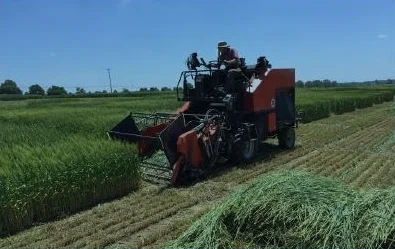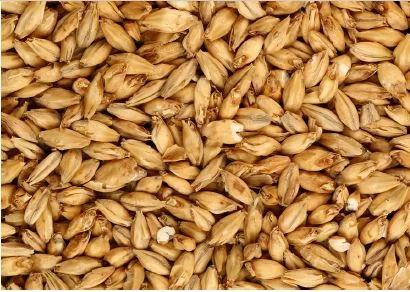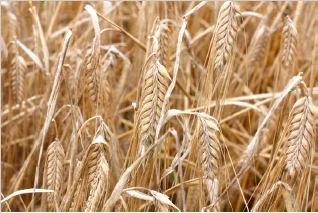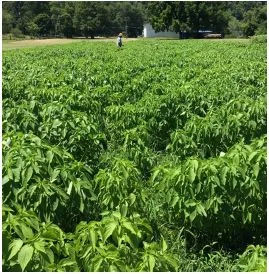Leadership of the Kentucky Small Grain Growers Association and Promotion Council attended the UK Wheat Field Day on May 8 to honor UK Wheat Breeder Dr. David Van Sanford for his many contributions to Kentucky's wheat industry.
Read MoreGrowing winter wheat and other cool season grains in Kentucky is not an easy task. And even though the current crop is still slowly progressing, my fellow growers and I are already looking at the challenges and opportunities of the next crop.
Read MoreThe center is a testament to the strong working relationship between UK specialists and Western Kentucky farmers with the idea coming from Logan County farmer Don Halcomb (Ky Small Grain Promotion Council Chairman) and Lloyd Murdock, UK extension soils professor emeritus.
Read MoreAfter a successful first year, we are pleased to announce the next series of trainings of the 2018 Wheat Field School at the University of Kentucky Research and Education Center (UKREC). This program is possible through the partnership and support of the Kentucky Small Grain Growers Association.
Read MoreThe November WASDE made minor changes to the 2017-18 wheat supply and demand projections, which is typical as there is little new production or demand information until the “final” estimates in January.
Read MoreChristian County is the leading wheat producing county in Kentucky for 2017, with production totaling 4,222,000 bushels, harvested from 53,000 acres. Wayne County had the highest average yield.
Read MoreAnnual UK Winter Wheat Meeting in Hopkinsville. CCA and Pesticide Credits approved.
Read MoreWheat is an important source of forage for many Kentucky growers. Approximately 20% of Kentucky’s
annual wheat acreage is not harvested for grain, and much of that acreage is utilized for forage production.
The objective of this project is to increase our understanding of the genes that affect the vernalization and photoperiod response in wheat.
Read MoreDespite sufficient total annual rainfall in Kentucky, irrigation for efficient crop production and for securing high yields becomes increasingly relevant because draught periods often occur
at times and crop growth stages when the water is needed.
he boom in distilleries and interest in locally-grown foods has combined to generate much interest in barley and rye for Kentucky. This has resulted in considerable interest from producers on current agronomic management practices for barley and rye.
Read MoreEvery year, vomitoxin levels caused by Fusarium graminearum, in soft red winter wheat are of major concern to wheat producers and millers. Current agronomic practices to reduce vomitoxin levels include planting moderately resistant wheat cultivars and fungicide applications at Feekes 10.5.1.
Read MoreThis objectives of this project were to monitor the abundance of aphid species and viruses in the fall 2016 and spring 2017 in research plots of Princeton; survey for presence of new invasive Sipha maydis in several regions of Western KY, and collect samples for virus detection; and to evaluate insecticide treatments for aphid management and BYDV’s percentages in treatments.
Read MoreThe overall objective of the research trials were to develop the best recommendations for managing Fusarium head blight (FHB; also known as scab) and the associated mycotoxin deoxynivalenol (DON; also known as vomitoxin) with foliar fungicides.
Read MoreThe Virginia Tech barley-breeding program is the largest and until recently was the only remaining public program in the eastern United States. The barley program is significantly diverse with breeding efforts focused on the development of superior, widely adapted, high yielding winter barley cultivars and a major focus on the incorporation of value-added traits geared towards the development of new markets.
Read MoreWork conducted at University of Kentucky and also by Chris Kummer has indicated that chia, Salvia hispanica, has the potential to be an economically viable new crop for Kentucky farmers, but agronomic improvements and/or additional product markets are needed.
Read MoreIn 2016, the irrigation system was calibrated and wheat was established that fall to examine the effect of wheat canopy temperature on final grain yield in 2017 growing season.
Read MoreWith these limited results, it appears that it might be possible to increase yields of corn and soybeans by 25% on the fragipan soils by using an annual ryegrass cover crop. We also expect to improve the yields of wheat. A 25% increase would result in $500,000,000 in increased returns to Kentucky producers per year or $5,000,000,000 over a 10-year period on the 1.5 million acres of cropable fragipan soils in Kentucky.
Read MoreKentucky Small Grain Grower leaders Pat Clements and Bernard Peterson were among 30 wheat farmers who attended the National Association of Wheat Growers DC fly-in to discuss the farm bill with Congress.
Read MoreKentucky grain farmers are harvesting corn and are getting to the point where they will decide if and how much wheat they will plant this fall. The main changes this year are a modest increase in wheat prices, a small increase in soybean prices, and a slight decrease in nitrogen prices. These changes will make planting wheat more attractive relative to last year. The following analysis attempts to quantify the extent of the relative change in profitability for 2017. The analysis includes estimated returns comparing double-cropped wheat/soybeans with full-season soybeans for the 2018 crop, and the likely implications for Kentucky grain farmers.
Read More


















